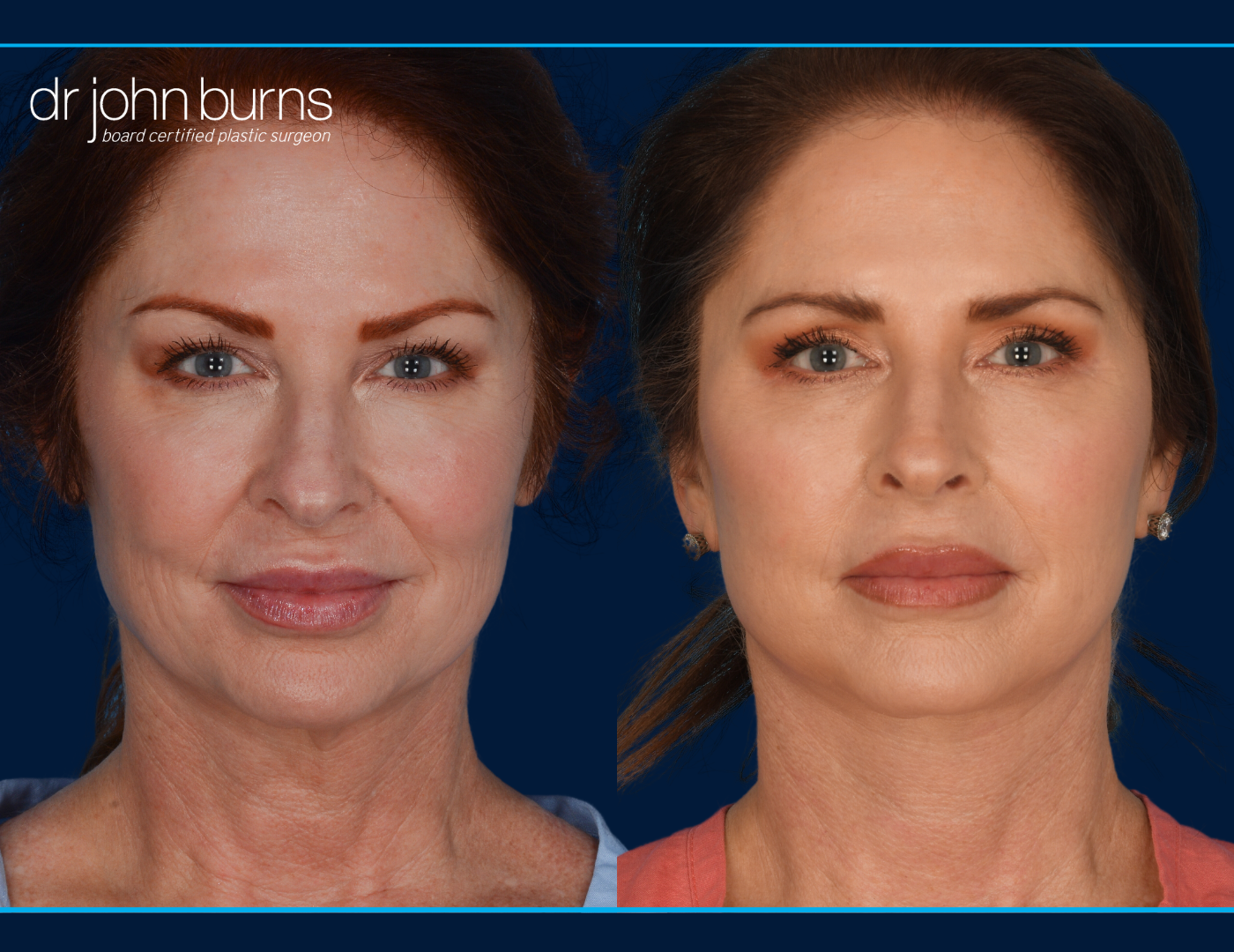April 2024
Facelift Recovery 101:
What To Expect At Home
What To Do Before Surgery To Make Recovery Easier
Facelift surgery is not a particularly painful procedure but it can leave you emotionally drained. Recovery from a facelift is more mental than physical. Because we look at our face constantly it can be difficult and even scary to see yourself bruised and swollen. But trust the process and believe in your surgeon because the end result will make it all worthwhile.
We've put together a timeline of what you can expect to help you prepare for the recovery process post-surgery.
Things To Keep In Mind Before Your Scheduled Facelift Surgery
Before surgery, it's important to mentally prepare yourself for the procedure by understanding that you will look bruised and swollen. Make sure you are in good physical condition. You might even make an appointment with your primary care doctor to do a checkup before the procedure. You should be free of cough, colds, or fever and be well hydrated before surgery. Stop all aspirin, blood thinners, diet pills, herbal supplements, and anything that might interfere with anesthesia or thin your blood. Don’t smoke or vape around the time of the procedure as nicotine can impair the healing.
Read More: The "Lift and Fill" Facelift: Natural Results That Last
On The Day Of Your Facelift Procedure
After your facelift, you will have a cotton dressing wrapped around your face and neck for the first 24 hours. You’ll have a “window” for your face but everything else will be covered. 2 small drain tubes are removed after one day.
The day after your procedure you will have your dressing and drains removed. We will gently shampoo your hair and face immediately following your facelift procedure. We will apply a light ace wrap-type compression dressing to be worn over the next several days.
The First Few Days After A Facelift
The first week is the most difficult in terms of recovery. Bruising and swelling are the main issues. Dr. Burns uses a medication in surgery called Tranexamic Acid (TXA) which stabilizes your body’s platelets and greatly decreases bruising. Your face will be swollen but can be helped with elevation, cool compresses, and mild steroid pills which you’ll take as directed the first week.
My advice is not to look in a mirror too much but simply to trust the process. We advise you to gently cleanse your hair and face daily with mild soap and water. You’ll be given an antibiotic ointment to apply to your incisions daily. Many patients will take the homeopathic herbs Arnica and Bromelain to help with bruising and swelling. Some patients use Aloe Vera gel to help soothe the skin that can feel tight with the initial bruising and swelling.
Many women and men comment that their discomfort and swelling is significantly improved with lymphatic massage done by a certified specialist.
After a week you’ll look and feel much better.
One Week Post Surgery
Most of your bruising will be resolved and swelling will be greatly reduced after about a week after surgery. Most patients will feel comfortable leaving their homes for short periods with makeup and sunglasses. You'll be able to resume driving, provided that you've stopped your prescription pain medication.
At this point, most patients can run short errands to the grocery store or cleaners.
Two Weeks After
Most patients will have numbness in their facial skin for several months and the facelift incisions will be red for several weeks. The numbness will resolve slowly and the incisions will turn from red to white over several months. Concealing makeup such as Dermablend or GloMinerals can be very helpful during the initial period of skin recovery.
How To Tell If You Need A Facelift or Neck Lift
Read More: Botox or Brow Lift: How To Tell What You Need
One Month After
One month post-facelift the swelling will resolve and you’ll see your rejuvenation results start to emerge. Oftentimes our patients tell us how they've received compliments about looking young and refreshed. Many patients are told they look thinner. The facelift scars will fade and you’ll begin to enjoy your results. You’ll return to your pre-surgery skincare routine and be cleared to begin your normal physical activities including working out. You’ll also be cleared to tint your hair and resume your skin health treatments like laser rejuvenation.
How To Make Your Recovery Easier At Home
The key to recovery at home is to be prepared by having everything you need. During the first few days, it helps to have someone with you who can help you with daily life. You might have blurry vision if you’ve had your eyelids done. You might need help with showers or navigating stairs. More than anything, it is helpful to have someone with you for basic needs and companionship.
You’ll need a bed that elevates or pillows to sleep on that elevate your head. Ice Packs to cool around your eyes help with swelling. It helps to meal prep and have a fully stocked food supply to take you through the first week. Make sure your prescriptions are filled and ready when you get home.
I advise putting away mirrors and simply trusting the process. Looking at yourself too much can cause unnecessary stress and anxiety as bruising and swelling ALWAYS resolve. Have loose-fitting, comfortable clothing that is easy to slip over your head. It may be hard to read and concentrate so find a good series to watch on Netflix that will help you pass the first few days.
It's ok to go outdoors and do a little walking, provided you are up for it. Walking will help clear your head and fresh air is always good for your mood.
Maintenance
You'll get a lot of life (approximately 10 years or more) out of your facelift but do keep in mind that the results are not permanent. Good maintenance is key to protecting your facelift and giving yourself the best results.
Here Are Some Tips To Help Your Facelift Results Last Longer
- Follow Post-Operative Care Instructions: Adhere strictly to the post-operative care instructions provided by your surgeon. This includes following all of our post-operative instructions and keeping all of your follow-up visits.
- Protect Your Skin from the Sun: Sun exposure can accelerate aging and cause skin damage, so it's essential to protect your skin by wearing sunscreen with SPF 30 or higher every day.
- Adopt a Healthy Lifestyle: Maintain a balanced diet rich in fruits, vegetables, lean proteins, and whole grains. Stay hydrated by drinking plenty of water, and avoid smoking and excessive alcohol consumption, as they can contribute to premature aging and skin damage.
- Establish a Proven Skincare Routine: Use medical-grade skincare products suitable for your skin type and concerns. We offer a complimentary skin care analysis for our patients at EpiCentre so you can learn more about your skin and how to protect your investment.
- Regular Facial Massages: Once healed, regular gentle facial massages can improve blood circulation, promote lymphatic drainage, and help maintain skin elasticity. Consider incorporating facial massages into your skincare routine to enhance the results of your facelift.
- Non-Surgical Maintenance Treatments: Depending on your individual needs, you may benefit from non-surgical cosmetic procedures such as injectables (e.g., Botox, dermal fillers), laser treatments, or chemical peels to address signs of aging and maintain your facelift results. A quarterly chemical peel, laser, or skin treatment can keep you looking young.
- Stay Hydrating And Get Sufficient Sleep: Proper hydration and adequate sleep are essential for overall skin health and can help your skin recover and regenerate effectively.
- Stay in Touch with Your Plastic Surgeon: We want to see you! Make sure to keep regular follow-up appointments to monitor your progress and address any concerns promptly. Throughout your healing journey, we'll provide personalized recommendations to help you maintain your facelift results effectively.
Facelift Before and After- Dallas, Texas- Dr. John Burns MD, FACS




Getting Facelift Rejuvenation in Dallas, Texas

Dr. John Burns in Dallas, TX, employs both artistry and skill in using advanced techniques that go beyond mere surgery – we specialize in creating results that are natural yet transforming.
Our team is curated to provide you with passionate and compassionate care throughout your journey. We are your advocates for a beautiful outcome that you will enjoy for years. Click the button below to get started with Dr. Burns and his team.
Stay In Touch
Follow us for news and information on plastic surgery procedures





